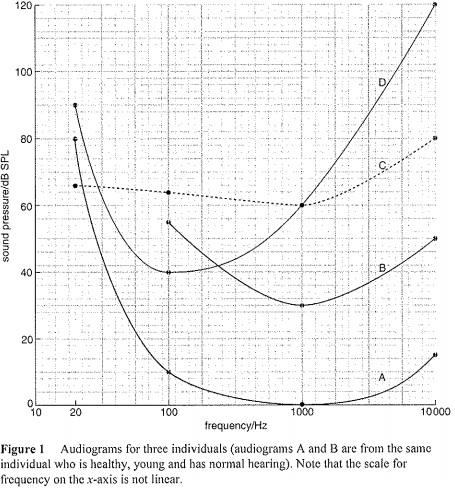Assignment:
AUDITORY SYSTEM
Figure 1 shows several audiograms (otherwise known as auditory threshold curves). This is a method of describing the sensitivity of the ear to different sounds. The pitch or frequency of sound is measured in units called Hertz (Hz). A pure tone of any given pitch can be generated at different levels of loudness. Loudness describes our perception of the sound, but the sound has a physical property of pressure that can be measured in units of decibels (dB SPL, where SPL stands for sound pressure level). To construct the audiogram, a sound of a particular frequency is created and its loudness is increased until the listener can just detect it. This is the threshold value. If you look at the audiogram for individual A (who has normal hearing), you will note that a very low frequency sound of 20 Hz only becomes audible at 80 dB SPL. Below 80 dB SPL, sounds of 20 Hz are not heard at all. In fact the range of frequencies used by human spoken language is about 40 to 3000 Hz, and conversational speech levels register, on average, somewhere around 60 dB SPL. However, a whisper of about 15 dB SPL can also be heard.
Questions:
1. How would I describe the four graphs shown in Figure 1 and what can be said about the hearing of these individuals?
Graphs A and B were both provided by the same individual. One of these audiograms was obtained by carrying out the recordings using
a soundproof laboratory. The other recording was obtained from the individual whilst sitting in an open-plan work-space.
2. Which graph was obtained from the laboratory and how can you tell this?
3. Which of graphs C and D shows conductive loss of hearing and what could be the cause?
4. What is the name of the type of hearing loss shown in the other graph (i.e. graph C or D) and what could have caused this hearing loss?
